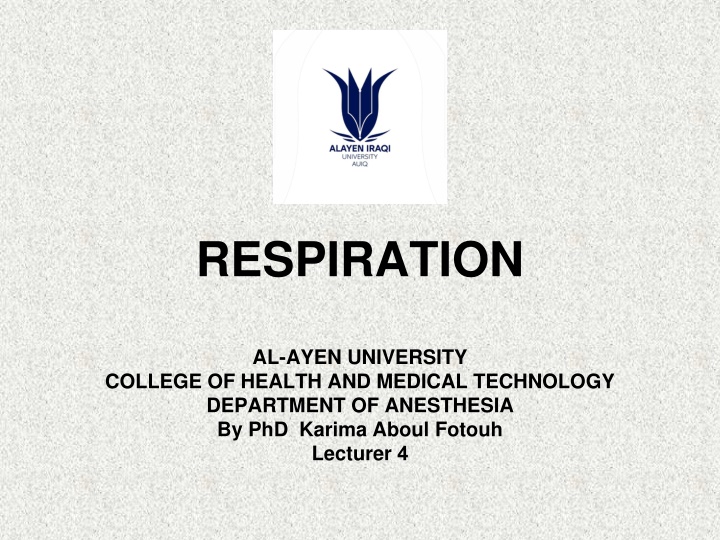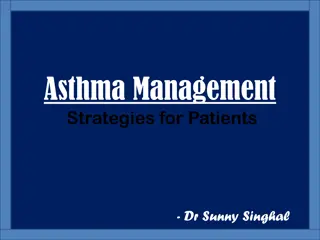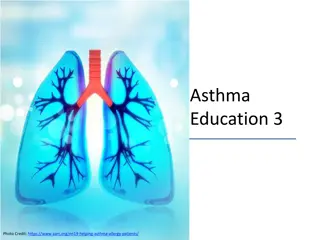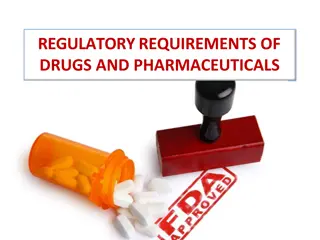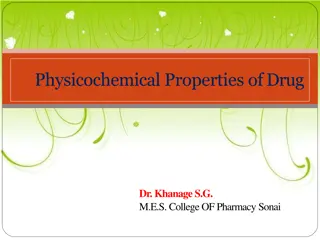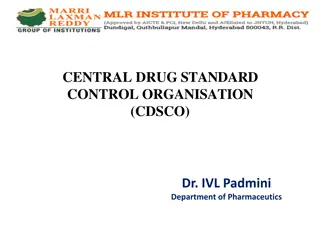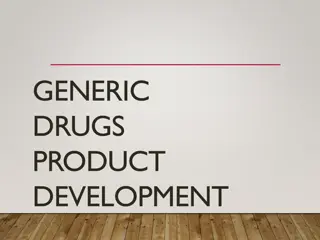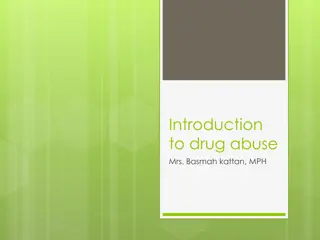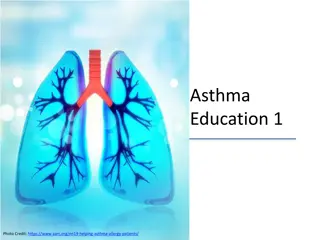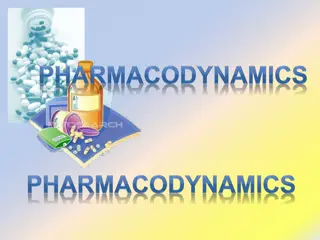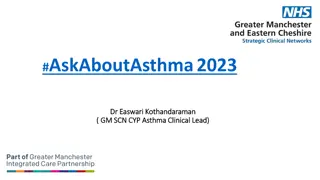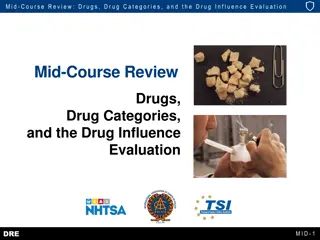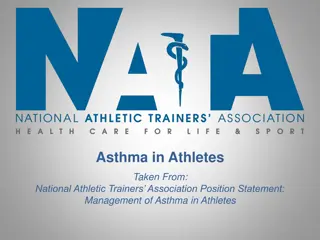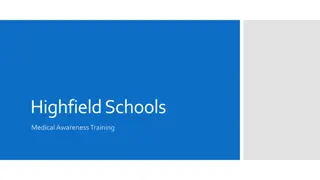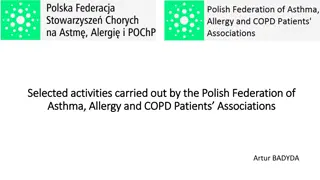Drug Treatment of Bronchial Asthma: Line of Treatment and Drugs Used
Bronchial asthma is characterized by increased airway resistance, leading to recurrent symptoms such as coughing, shortness of breath, and chest tightness. Treatment involves bronchodilators, oxygenation, expectorants, and control of predisposing factors. Commonly used drugs include sympathomimetics, xanthines, muscarinic receptor antagonists, and mast cell stabilizers.
Download Presentation

Please find below an Image/Link to download the presentation.
The content on the website is provided AS IS for your information and personal use only. It may not be sold, licensed, or shared on other websites without obtaining consent from the author.If you encounter any issues during the download, it is possible that the publisher has removed the file from their server.
You are allowed to download the files provided on this website for personal or commercial use, subject to the condition that they are used lawfully. All files are the property of their respective owners.
The content on the website is provided AS IS for your information and personal use only. It may not be sold, licensed, or shared on other websites without obtaining consent from the author.
E N D
Presentation Transcript
RESPIRATION AL-AYEN UNIVERSITY COLLEGE OF HEALTH AND MEDICAL TECHNOLOGY DEPARTMENT OF ANESTHESIA By PhD Karima Aboul Fotouh Lecturer 4
RESPIRATION Drug treatment of bronchial asthma Bronchial asthma increase in airway resistance or bronchial tone. There is recurrent attacks of coughing, shortness of breath, chest tightness and wheezes which are due to bronchospasm, mucosal thickening from oedema,
Bronchospasm may be induced by non- antigenic stimuli which may due to inflammation of airway mucosa, this is called non-specific bronchial hyper reactivity. Also exercise and some drugs induce asthma.
Line of treatment: Bronchodilators. Adequate oxygenation. Expectorants (alkaline, nauseant) and mucolytic agents. Reduction of response of antigen/antibody reaction by adrenal steroids, cromoglycate.. Control predisposing factors, e.g., infection. Hyposensitization and avoidance of antigen. Bronchodilatation can be produced by 2agonists, methylxanthines and muscarinic antagonists.
Drugs used in bronchial asthma include: 1- Sympathomimetics: -receptor stimulants: Selective 2agonists: Short acting (4hrs duration): Salbutamol (Albuterol), terbutaline. Long acting (12hrs duration): Formoterol and salmeterol. ritodrine. They produce bronchodilatation, reduction of bronchial secretion and inhibit release of mast cell content (allergotoxins). Adverse effects: skelatal muscle tremors. Tachycardia may occur if given in large doses. Non-selective ( 1and 2) e.g. adrenaline, isoprenaline, orciprenaline (metaproterenol), ephedrine ( not commonly used).
2-Xanthines: (caffiene, theophylline and theobromine). Theophylline They have spasmolytic effect on bronchi Aminophyline (250 mg) is used in acute attack and in prophylaxis, given slowly diluted I.V., rectally or orally. The therapeutic plasma concentration is 10-20 mg/L.Anorexia, nausea, vomiting, headache and anxiety start at 15 mg/L. Higher levels than 40mg/L induce convulsion and arrhythmias. Children clear aminophylline more rapid than adults while neonates and young infants have slow clearance.
3-Muscarinic receptor antagonists: Ipratropium and tiotropium 4-Cromolyn and Nedocromil (metered dose inhaler). They inhibit the early response to antigen challenge on mast cells ( mast cells stabiliser), prevent histamine release from mast cells and inhibit inflammatory response to allergens
5-Leukotriene pathway inhibitors: Zileutin Zafirukast
6-Adrenal steroids: are effective in asthma via: Anti-inflammatory action and reduce mucosal oedema. Modification of immune response and inhibit cytokines production. Increasing the response of -agonists and cAMP. Inhaled corticosteroids include: beclomethasone (becotide) and budesonide. They can be Oral corticosteroids e.g. prednisolone can be used which is gradually reduced. I.V. hydrocortisone in status asthmaticus.
7-Other drugs: Anti-IgE monclonal antibodies: K+ channel openers as cromokalim are under trials in asthma. Ca++channel blockers inhibit spasm induced by exercise, histamine and other stimuli. Nitric oxide (NO) donors are tried in asthma. N.B. Anti-histaminics (H1blockers): They are of little importance because histamine has minor role in asthma.Any benefit is related to atropine like action and sedative effect on CNS. Prostaglandins (PGE2) produce bronchodilatation: but it is irritant.
Drugs contraindicated in bronchial asthma: Morphine (inhibits RC Barbiturates. Histamine and its releases (morphine, curare, trimethaphan). Parasympathomimetics. Non-selective -blockers. NSAIDs as aspirin, indomethacin. In patients developing bronchospasm following NSAIDs as aspirin, paracetamol is used instead.
N.B.: Bronchial asthma is classified according to severity into: Mild intermittent asthma (step 1):symptoms occur less than two times per week and asymptomatic in between. Mild persistent asthma (step 2): symptoms occur more than two times per week. Moderate persistent asthma (step 3): daily symptoms occur and exacerbation more than two times per week. Severe persistent asthma (step 4): continual symptoms occur with limited physical and frequent exacerbation.
Management: 1) For quick relief give inhaled 2agonist as salbutamol. 2) In mild intermittent asthma no daily medication is required. 3) In mild persistent asthma give low dose inhaled corticosteroid or cromolyn or nedocromil or sustained release theophylline or leukotriene modifier. 4) In moderate persistent asthma give moderate dose of inhaled corticosteroid + long acting bronchodilator (as theophylline, 2agonist) 5) In severe persistent asthma, give high dose of inhaled corticosteroid and long acting bronchodilator (as 2 agonist or theophylline slow release) and long-term use of oral corticosteroid. 6) If symptoms are not controlled patient is hospitalized and give: Oxygen 40-60%. Inhaled 2agonist. Ipratropium inhalation. Hydrocortisone 200mg I.V. /4-6 hours for 24 hours and oral predinsolone for 2 weeks.
Cough Therapy I-Treatment of dry (useless) cough by: A) Peripheral anti-tussives which depress the input of stimuli, and include: 1. Demulcent as lozenges and pastilles in sore throat and pharyngitis.
B) Central anti-tussives: inhibit medullarry cough center. 1. Narcotic addictive as morphine, 2. Narcotic relatively non addictive e.g. Codeine phosphate and dihydrocodeinone, pholcodine ( has little or no analgesic or euphoric effects). 3. Non-narcotic non addictive as: Dextromethorphan (no analgesic action). Narcotine (opium alkaloid from benzlisoquinoline group). Non-opiate synthetic derivatives as: benzonatate, chlorphedianol.
II- Treatment of productive (useful) cough: 1- Sedative Expectorants: a)Alkaline expectorants: b)Nauseant expectorants: c)Saline expectorants: sodium or potassium iodide.
2-Stimulant (aromatic) expectorants: creosote, guaiacol, terpene hydrate.
3-Mycolytic agents: They liquify viscid secretions so are not true expectorants, but enhance their efficacy. Used in acute and chronic bronchitis. Bromhexine (bisolvon): It reduce the viscosity of bronchial secretion by depolymerization of the mucopolysaccharides. Geven orally. Acetylcysteine and S-carboxymethylcysteine:
Cyanide poisoning Cyanide combine with Fe+3of cytochrome oxidase histotoxic hypoxia. Treatment by either: c. Vit.C or methylene blue to reduce met Hb.
